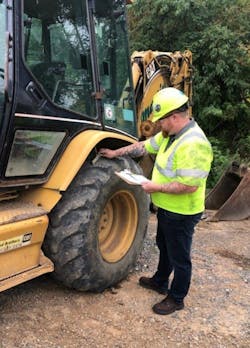Data-Driven: Construction Fleets Want More Info Than Ever, Says STTC
Selling tires to construction fleets has always been a tough business. And it has become even more challenging as construction companies apply extra scrutiny to their tire budgets and purchasing decisions due to continued, COVID-19-driven uncertainty.
This, in turn, is forcing construction tire dealers to lean even more heavily on performance tracking and analytics to help clients make better decisions about their tire assets, according to Kyle Kutzler, director of OTR tires, Service Tire Truck Centers (STTC), which is based in Bethlehem, Pa., and has 53 locations.
“We’ve been selling OTR tires for a few decades,” says Kutzler. “We service every customer, from smaller construction and asphalt companies to large gravel and mining operations — and everything in between. And when it comes to construction, specifically, we service everything from wheelbarrow tires to loader tires.
“COVID-19 has changed the way we do business a little bit. And construction fleets are looking at things differently. They’re educating themselves differently and they’re purchasing differently.
“Before COVID-19, decision-makers may have been thinking, ‘If it’s going well and what we’re using is working well,’ they would probably (continue to) buy off that basis,” he says. “But the pandemic has shaken up the market a bit. Owners are looking at their budgets. They’re doing deep dives on their purchasing. You need to provide data to them. Data is going to drive a lot of decisions and a lot of sales.”
An increasing number of construction tire customers “have gotten savvy to analytics and understanding how a piece of equipment is moving within their operation and the degree at which the vehicle travels, when speed increases, when it slows, how the driver operates the vehicle — it goes beyond the cost of the tire and having the right tire for the application,” he says. STTC performs fleet surveys and equipment checks for its construction fleet customers.
“We track the tire through its full life cycle, which gives customers accurate cost-per-hour.”
The dealership promotes Michelin and Camso brand OTR tires, “which are definitely not the cheapest. People need to justify to their supervisors why they’re choosing a tire that might cost (significantly more) than another tire. We offer these services as a value-add,” instead of charging for them.
STTC also retreads OTR tires. And the dealership operates an in-house OTR tire repair center, where trained technicians perform spot and section repairs on tires up to 35 inches in diameter. Performing repairs in-house enables faster turnaround times, which customers appreciate, says Kutzler.
The company’s tire repair business increased during the early weeks of the pandemic. “I think there was a lot of uncertainty with all the shutdowns. Customers weren’t sure what was going to happen and were looking to utilize all of their assets. When you’re buying tires that cost thousands of dollars, fleets aren’t going to over-purchase, not knowing what the future is going to hold.”
The “very forecasted and budgeted” nature of construction tire purchasing benefits STTC, as well, he explains. “It’s equally important for us to understand when the customer is going to buy because it helps us reduce the amount of inventory sitting around. Otherwise, we’d have millions of dollars of tires laying around.”
STTC’s focus on data and analytics enabled it to recently displace several competitors at a major client, according to Kutzler. “We had a target fleet that dealt with multiple tire suppliers and bought multiple brands and had a few locations. We performed surveys and tracking consistently for four years to provide them with a cost-per-hour on the products in their fleet.
“Prior to this, the customer had no data and no records of anything” pertaining to tire performance, he says. “We introduced retreading to the customer and we introduced an asset management system. We also pooled all of their tires into one central location. Before that, their locations had run independently.
“We lowered their overall maintenance budget and in return, we won 100% of their business. By providing four years of hard data, we proved to them what products, application-wise, worked best for their fleet. We also showed them how to utilize their casings.”
About the Author
Mike Manges
Editor
Mike Manges is Modern Tire Dealer’s editor. A 28-year tire industry veteran, he is a three-time International Automotive Media Association Award winner, holds a Gold Award from the Association of Automotive Publication Editors and was named a finalist for the prestigious Jesse H. Neal Award, the Pulitzer Prize of business-to-business media, in 2024. He also was named Endeavor Business Media's Editor of the Year in 2024. Mike has traveled the world in pursuit of stories that will help independent tire dealers move their businesses forward. Before rejoining MTD in 2019, he held corporate communications positions at two Fortune 500 companies and served as MTD’s senior editor from 2000 to 2010.

